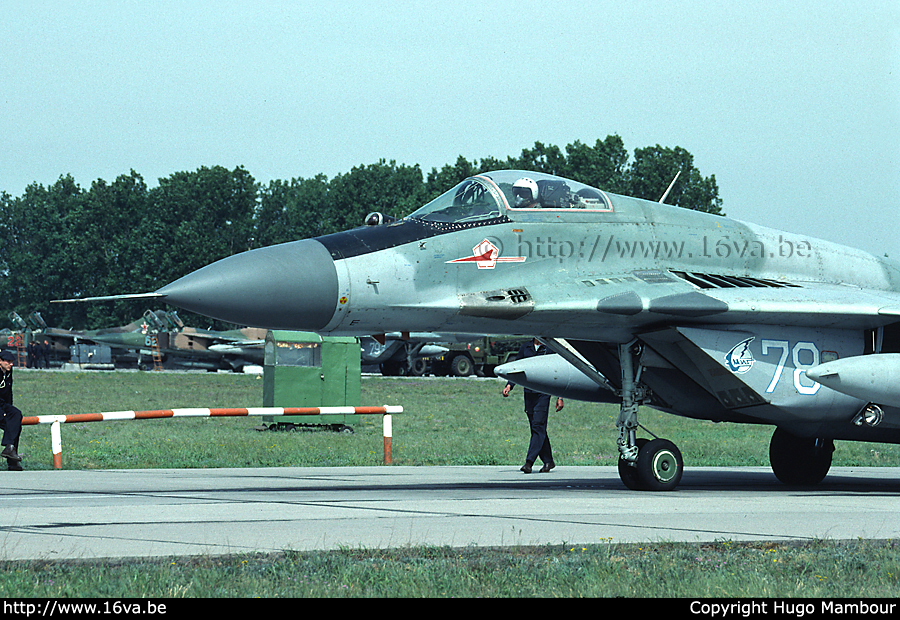

Ce "Fulcrum-C" du 787.IAP vu le jour du départ d'Allemagne à Finow le 11 mai 1993, portait sur le nez l'emblème "Otlitchniy Samolet" (Avion Excellent).
Cette décoration saluait la bonne maintenance d'un appareil particulier par son équipe technique. Pour cela, il fallait obtenir une évaluation d'au moins
4,6 points sur 5 pendant une période de six mois consécutifs.
Les différents critères pour son obtention et les récompenses octroyées étaient les suivants :
1. Tous les avions de l'unité participent à la comptétition socialiste pour l'obtention du titre.
2. Le titre "Avion Excellent" est attribué à un appareil dont l'équipage excelle dans l'entraînement au combat et sur le plan politique.
3. L'avion doit satisfaire aux obligations suivantes :
a) Etre constamment disponible et ne pas être immobilisé à cause de problèmes de maintenance;
b) Réaliser une moyenne d'heures de vol mensuelle au moins égale à celle des autres avions de l'unité pour la période de notation;
c) Ne pas subir de panne en vol ou au sol pendant la période de notation;
4. A la fin de chaque période d'entraînement, les commandants des unités subordonnées présentent au commandant de l'unité les avions retenus pour le titre
"excellent". Un titre confirmé est valable pour un an.
5. Une commission nommée par le commandant d'unité attribue et confirme le titre "Avion Excellent". Le commandant en second des services techniques préside
cette commission.
6. Un certificat et un fanion représentant l'emblème "Excellent" est présenté à l'équipe d'un avion excellent. Le fanion est cousu sur le cache du tube pitot.
L'emblème est peint sur les côtés gauche et droit du fuselage
et sur les portes de la hangarette.
7. La commission confère aux membres du personnel technique qui ont excellé lors de la comptétion, une récompense sous la forme d'une prime valable pour un an.
Ils sont prioritaires lors des sélections pour
l'entraînement, pour l'attribution de bons de voyage à destination de sanatoriums ou de centres de repos
ainsi que pour le choix de la période de leur prochain congé et reçoivent un meilleur logement.
Reste à voir dans quelle mesure toutes ces procédures et récompenses étaient respectés dans les faits.
This 9-13 model of the 787.IAP seen at Finow on May 11, 1993 before its last take off from Germnay, had an "Otlichniy Samolet" (Excellent Aircraft)
badge painted on its nose. This emblem denoted an excellent maintenance of an aircraft by its technical crew.
An evaluation of the aircraft's technical condition of at least 4.6 on a 5-point scale for a period of six months was the official criterion to get it.
This Statute defines the procedure for awarding an aircraft the title "Excellent Aircraft" and the requirements for this award.
1. All unit aircraft participate in socialist competition for award of this title.
2. The title "Excellent Aircraft" is awarded to an aircraft whose crew members excel in combat and political training.
3. The aircraft must satisfy the following requirements:
a) Be constantly serviceable and have no down time attributable to maintenance;
b) Have an average number of monthly flying hour at least equal to that of the unit's aircraft for the rating period;
c) Have no malfunctions in the air or on the ground during the rating period.
4. At the end of each training period, subunit commanders present to the unit commander aircraft for award of the "excellent" title. A confirmed title is valid for a year.
5. A commission appointed in an order the unit commander issues confers and confirms the title "Excellent Aircraft." The Deputy Commander for Aviation Engineering Services chairs this commission.
6. A certificate and pennant with the "Excellent" emblem is presented to the crew of an excellent aircraft. The pennant is sewn on the pitot-static tube cover. The emblem is placed on the left and
right sides of
the aircraft fuselage and on the doors of the shelter.
7. The commission confers on members of the technical staff who have excelled in competion a reward in the form of an incentive valid for one year. They are given priority in selection for training,
receive better
housing, are givenpriority in distribution of travel vouchers for sanatoria and rest homes and in selection of the time of their next leave.
It remains to be seen to what extent all these procedures and rewards were respected in practice.
